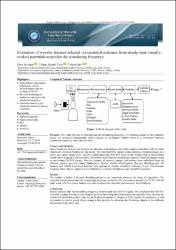| dc.contributor.author | Sayilgan, Ebru | |
| dc.contributor.author | Yüce, Yılmaz Kemal | |
| dc.contributor.author | İşler, Yalçın | |
| dc.date.accessioned | 2022-09-23T08:33:35Z | |
| dc.date.available | 2022-09-23T08:33:35Z | |
| dc.date.issued | 2021 | en_US |
| dc.identifier.uri | https://hdl.handle.net/20.500.12868/1662 | |
| dc.identifier.uri | https://dergipark.org.tr/tr/pub/gazimmfd/issue/60572/664583 | |
| dc.description.abstract | Electroencephalography (EEG) is a noninvasive method to record brain activities. Among different EEG recording methods, the recording, while a visual stimulation is shown to the subject, is one of the most popular methods. Recently, steady-state visually-evoked potentials (SSVEP) where visual objects are blinking at a fixed frequency have been commonly-used method in brain-computer interfaces. Although various features extracted from SSVEP records have been used, the use of features from wavelet transform should be preferred due to the nonstationary structure of these signals. In this study, the combination of mother wavelet and classifier, which gives the highest accuracy to determine the stimulating frequency, is examined by applying common wavelet features to inputs of classifiers. Features of energy, variance, and entropy were extracted for well-known five EEG frequency bands using six different mother wavelets. Then, classifier performances of six basic classifiers were compared. This study was run for both each subjects individually and all subjects together. Results showed that (i) ANOVA-based feature selection reduces the performances, (ii) there is no unique combination of classifier and mother wavelet while evaluating each subject individually, (iii) the highest performance was achieved by combination of ensemble learner and Reverse Biorthogonal wavelet while evaluating all subjects together. | en_US |
| dc.language.iso | eng | en_US |
| dc.relation.isversionof | 10.17341/gazimmfd.664583 | en_US |
| dc.rights | info:eu-repo/semantics/openAccess | en_US |
| dc.subject | Machine learning | en_US |
| dc.subject | Signal processing | en_US |
| dc.subject | BCI | en_US |
| dc.subject | SSVEP | en_US |
| dc.subject | ANOVA | en_US |
| dc.title | Evaluation of wavelet features selected via statistical evidence from steady-state visually-evoked potentials to predict the stimulating frequency | en_US |
| dc.type | article | en_US |
| dc.contributor.department | ALKÜ, Fakülteler, Rafet Kayış Mühendislik Fakültesi, Bilgisayar Mühendisliği Bölümü | en_US |
| dc.identifier.volume | 36 | en_US |
| dc.identifier.issue | 2 | en_US |
| dc.identifier.startpage | 593 | en_US |
| dc.identifier.endpage | 605 | en_US |
| dc.relation.journal | Journal ot the Faculty of Engineering and Architecture of Gazi University | en_US |
| dc.relation.publicationcategory | Makale - Uluslararası Hakemli Dergi - Kurum Öğretim Elemanı | en_US |


















